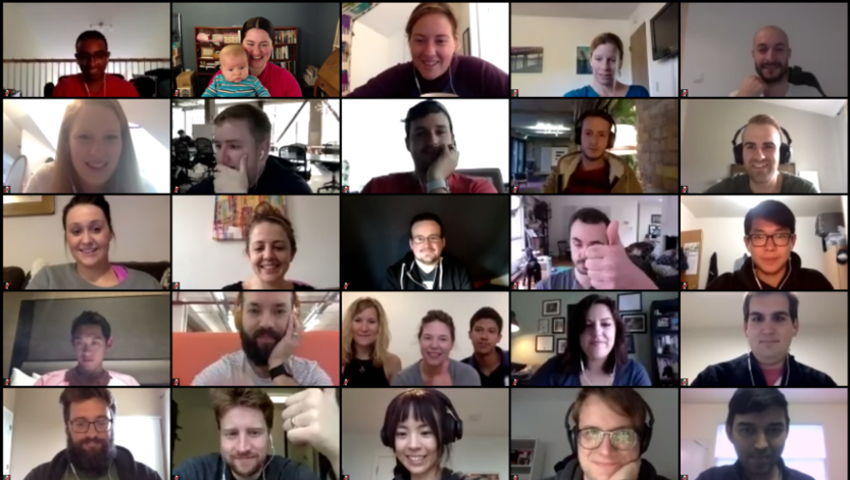In the two weeks since the COVID-19 crisis began sending Australian workers to shelter at home and work remotely, there has been a record number of new data service connections.

Spike in new connections
Prior to COVID-19, many Australian businesses already had some form of remote network access in place - commonly a VPN or Office 365. But, no one was planning for their entire workforce, overnight, en masse, to shift to the safety of working from home.
Suddenly, with virtually no notice, organisations had an urgent need to scale up for remote working, ensuring that all employees had the tools to continue working productively from home. This scenario was playing out across corporate Australia.
The first priority for organisations was to make sure that all their people had connectivity - to each other, to customers, to the office network for critical files and collaboration.
"It's no surprise, with everyone suddenly working from home, that there would be a need for more mobile connections. MobileCorp has been working overtime to get all our customers up and running with the new Telstra connections they need," says managing director, Stephen Aravopoulos.
"Extra connections have been needed for a range of reasons all linked to the WFH shift. These include supplying staff who don't usually work from home with a service; upgrading staff who had a BYOD consumer service to a faster and more reliable Telstra business plan; deploying new mobile WiFi devices for home offices; and securing additional pooled data allowances."

Upgrading data pool a priority
At the same time as getting everyone connected, organisations were planning for the inevitable increase in data consumption. No one really knows what this is going to look like longer term, but it doesn't take a data scientist to realise consumption is going to be greater than it has ever been before.
Not only is everyone working from home, but most of us are using data fairly constantly. Internet searches, files being accessed on OneDrive, and literally thousands of people spending hours on Microsoft Teams or Zoom video meetings.
If you google 'How much data does a Zoom meeting use', the answer is kinda scary. According to WhistleOut who make it their business to know these things, a Zoom 'high quality call' (which is the lowest quality available) will range from 540MB-810MB in data consumption per hour depending on whether it is a one-to-one call, or a group session.
By default, Zoom should only be using the minimum amount of bandwidth - so just look at the 'High' figures in the tables above. On a PC or Mac, HD video has to be enabled manually, and 1080p is only available for customers with Enterprise plans.
For workers using their unlimited consumer home WiFi plan this data consumption will be of no concern; but for organisations paying for corporate plans with limited data - often 3 to 9 GB per month - that's clearly not going to be enough data for most workers.
"Once everyone's connected and able to work productively, the next concern is the data allowance. We are currently working through this issue with a range of customers and figuring out how best to manage this.
"Mobile data usage, mobile expense management and visibility of costs are going to become even more important, the longer we are working remotely."
Mobile WiFi devices in strong demand
MobileCorp has also experienced very heavy demand for mobile WiFi devices. These range from tiny portable dongles through to business-grade routers like the Nighthawk and Cradlepoint.
Meanwhile the iPhone 8 has been sold out across Australia for weeks, and there is a critical shortage of many other mobile phones.
"There is a critical global shortage of iPhones and iPads, and many other phones are also in short supply. This means its a case of ordering in advance if new devices are going to be needed. There is no point in waiting to order when phones become available, as all available devices are going straight to fulfil back orders. If you're not in the queue, you have no chance of getting a device from any of the major carriers.
"We have also distributed hundreds of mobile WiFi devices and the less expensive devices are becoming more difficult to source. We are seeing many organisations purchasing more robust business-grade routers like the Nighthawk or even Cradlepoint to set up reliable, fast home connections."
Meanwhile some industries are increasing operations
While customers in the retail, travel and hospitality have been critically impacted by the COVID-19 crisis, others are attempting to carry on as best they can, and still others are working overtime to contribute to the pandemic response.
"MobileCorp has customers like Medtronic whose ventilators, respiratory filters, oxygenation machines and pulse oximeters are being used by healthcare professionals on the front lines of this fight.
"We also serve food manufacturing customers like George Weston Foods whose products include Tip Top breads and a wide range of meat smallgoods; Inghams who are Australia's largest poultry suppliers; and Uber Eats who have ramped up operations to cater to people sheltering in place.
"It's a privilege to provide ongoing support to companies who are making a difference for the benefit of the community."
Read MobileCorp's COVID-19 Operations Status Report here
PS: If you are in sheltering in place and have extra time available, you might like to invest in up-skilling your knowledge by reading our Guide to Five Emerging Technologies. We think these five are worthy of your time investment, because when this crisis has passed, the Recovery will offer a new appetite for digital transformation.